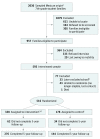Effect of Middle School Interventions on Alcohol Misuse and Abuse in Mexican American High School Adolescents: Five-Year Follow-up of a Randomized Clinical Trial
- PMID: 29562080
- PMCID: PMC5875338
- DOI: 10.1001/jamapsychiatry.2018.0058
Effect of Middle School Interventions on Alcohol Misuse and Abuse in Mexican American High School Adolescents: Five-Year Follow-up of a Randomized Clinical Trial
Abstract
Importance: Substance abuse preventive interventions frequently target middle school students and demonstrate efficacy to prevent early onset and use of alcohol and illicit drugs. However, evidence of sustained results to prevent later patterns of alcohol misuse and more serious alcohol abuse disorders has been lacking, particularly for US Latino populations.
Objective: To test whether a universal middle school prevention program can reduce the frequency of alcohol misuse and rates of alcohol use disorder 5 years after implementation with a Mexican American sample.
Design, setting, and participants: A previous randomized clinical trial was conducted with 516 Mexican American 7th graders and at least 1 parent who identified as having Mexican origin. Three annual cohorts of families were recruited from rosters of 4 middle schools and randomized to the 9-session Bridges/Puentes family-focused group intervention or a workshop control condition. Recruitment, screening, pretest, and randomization occurred in the same academic year for each cohort: 2003-2004, 2004-2005, and 2005-2006. Data acquisition for the follow-up assessments of late-adolescent alcohol misuse and abuse, which were not included in the initial randomized clinical trial, was conducted from September 2009 to September 2014; analysis was conducted between August 2016 and July 2017. In this assessment, 420 children (81.4%) of the sample were included, when the majority were in their final year of high school.
Interventions: The 9-session Bridges/Puentes intervention integrated youth, parent, and family intervention sessions that were delivered in the spring semester at each school, with separate groups for English-dominant vs Spanish-dominant families. The control workshop was offered during the same semester at each school, also in English and Spanish.
Main outcomes and measures: Primary outcomes were diagnostic assessment of lifetime alcohol use disorder in the 12th grade, 5 years after the intervention, based on the Diagnostic Interview Schedule for Children and past-year frequency of alcohol use, binge drinking, and drunkenness based on the 2001 Youth Risk Behavior Survey.
Results: Of the 420 participants, 215 (51.2%) were girls (mean [SD] age, 17.9 [0.62] years). The intervention reduced the likelihood of having an alcohol use disorder (β = -.93; SE, 0.47; P = .047; odds ratio, 0.39). Intervention associations with past-year alcohol use frequency, binge drinking, and drunkenness were moderated by baseline substance use. The intervention reduced the frequency of alcohol use (β = -.51; SE, 0.24; P = .04; Cohen d = 0.43) and drunkenness (β = -.51; SE, 0.26; P = .049; Cohen d = 0.41) among youth who reported any previous substance use at baseline (T1 initiators) but not among those who had not initiated any substance use (T1 abstainers) at baseline. For past-year binge drinking, the intervention finding did not reach statistical significance among T1 initiators (β = -.40; SE, 0.23; P = .09) or T1 abstainers (β = .23; SE, 0.14; P = .11).
Conclusions and relevance: Study results support an association between a universal middle school intervention and alcohol misuse and alcohol use disorders among Mexican American high school students and implementation of universal middle school interventions to reach Latino communities.
Conflict of interest statement
Figures

References
-
- US Department of Health and Human Services Facing Addiction in America: The Surgeon General's Report on Alcohol, Drugs, and Health. 2016. https://addiction.surgeongeneral.gov/. Accessed July 15, 2017. - PubMed
-
- Stueve A, O’Donnell LN. Early alcohol initiation and subsequent sexual and alcohol risk behaviors among urban youths. Am J Public Health. 2005;95(5):887-893.https://www.ncbi.nlm.nih.gov/entrez/query.fcgi?cmd=Retrieve&db=PubMed&li... - PMC - PubMed
-
- DeWit DJ, Adlaf EM, Offord DR, Ogborne AC. Age at first alcohol use: a risk factor for the development of alcohol disorders. Am J Psychiatry. 2000;157(5):745-750.https://www.ncbi.nlm.nih.gov/entrez/query.fcgi?cmd=Retrieve&db=PubMed&li... - PubMed
-
- Grant BF, Stinson FS, Harford TC. Age at onset of alcohol use and DSM-IV alcohol abuse and dependence: a 12-year follow-up. J Subst Abuse. 2001;13(4):493-504.https://www.ncbi.nlm.nih.gov/entrez/query.fcgi?cmd=Retrieve&db=PubMed&li... - PubMed
-
- Hingson RW, Heeren T, Winter MR. Age at drinking onset and alcohol dependence: age at onset, duration, and severity. Arch Pediatr Adolesc Med. 2006;160(7):739-746.https://www.ncbi.nlm.nih.gov/entrez/query.fcgi?cmd=Retrieve&db=PubMed&li... - PubMed
Publication types
MeSH terms
Grants and funding
LinkOut - more resources
Full Text Sources
Other Literature Sources
Medical
Miscellaneous

